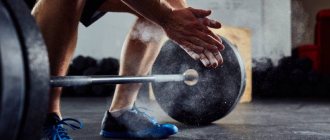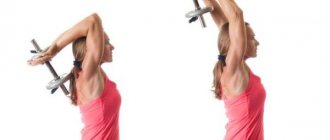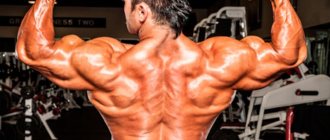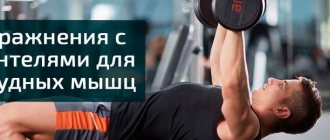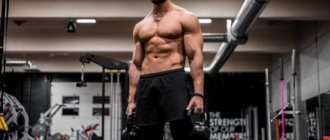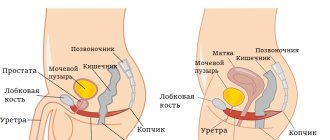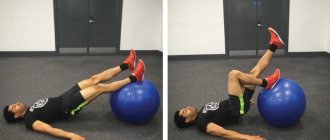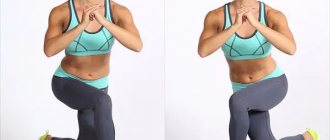The driving force of any novice bodybuilder is the desire to differ from others in the degree of their physical development. It cannot be otherwise. What is the first thing that catches your eye in a physically developed person? Of course it is his torso that makes him stand out from the rest. What is the basis of a massive beautiful torso? Most of it is naturally formed by the pectoral muscles. Developed pectoral muscles are what an athlete constantly strives for - this is his calling card as a bodybuilder.
The pectoral muscles are the very first muscle group that beginners pay attention to. But what is the right approach to effectively developing the muscles in this area? The answer is simple - like all other muscle groups. Namely, by carrying out systematic high-quality training and observing a diet, pharmaceutical support and rest.
The pectoralis muscle is a large muscle. It can be roughly divided into sections: the lower, central and upper parts of the pectoral muscle. Each exercise promotes the development of a specific department(s). What exercises are aimed at developing the pectoral muscles? Let's look at exercises that will help you create a program for training your pectoral muscles in the gym.
Bench press on a horizontal bench (Basic exercise)
The flat bench press is the main basic exercise for developing the pectoral muscles. The emphasis of the exercise shifts to the central and lower part of the chest.
Correct execution of the exercise:
- The horizontal bench press exercise is performed on a special bench equipped with mounts for a barbell. Before starting the exercise, you need to set the desired weight of the apparatus and position yourself correctly on the bench. The correct position is to ensure that your back is completely adjacent to the bench, without bending. It is advisable to spread your legs wider in order to maintain balance. The hands on the bar are positioned elbow-width apart so that when moving the bar, the forearms move parallel to each other.
- The mechanics of performing the exercise consist of raising/lowering the barbell in a vertical plane. At the top point the projectile is held at outstretched arms. At the bottom it touches the lower part of the chest. When doing this, do not bounce the barbell off your chest. As you move, try to control the bar. It happens that a lot of weight on a barbell has an uncomfortable effect on the ligaments of the hands. In such cases, it is worth using special elastic garters.
The exercise consists of 2-3 warm-up approaches and 3 working approaches. Warm-up approaches are done with light weights. The weight of the apparatus in the warm-up approaches gradually approaches the weight in the working approach, preparing the muscles and joints for maximum loads. Number of repetitions in warm-up and working approaches: 6-8.
For a visual representation of how to perform the exercise correctly, watch the video below:
Bench press. execution technique.
How to load muscles
You must load your muscles more and more each time, gradually increasing the load. The so-called progressive resistance is necessary in order to achieve the reaction of the muscles, they begin to grow and become stronger. Please note that this does not mean that you have to fully load the barbell. The main thing here is not to overdo it. You just need to lift enough weight so that the muscles get tired, but not destroyed. Do you feel ready to move on? Watch this workout from Vladislav Sidorenko to take your big muscle growth training to the next level.
Advice. When performing a specific exercise, use a weight that you can perform 8-12 reps with. If you are able to perform 12 reps (the upper end of the range) with good form, then next time you can do this exercise, you can add, for example, 2.5 - 5 kg.
Incline Bench Press (Basic Exercise)
The incline bench press is a basic exercise for developing the pectoral muscles.
The emphasis of the exercise shifts to the upper and central part of the chest. Correct execution of the exercise:
- The incline press exercise is performed on a special incline bench equipped with barbell attachments. Before starting the exercise, you need to set the desired weight of the apparatus and position yourself correctly on the bench. The correct position is to ensure that your back is completely adjacent to the bench, without bending. It is advisable to spread your legs wider in order to maintain balance. The hands on the bar are positioned elbow-width apart so that when moving the bar, the forearms move parallel to each other.
- The mechanics of performing the exercise consist of raising/lowering the barbell in a vertical plane. At the top point the projectile is held at outstretched arms. At the bottom it touches the upper part of the chest. Try to control the bar as you perform the exercise.
The exercise consists of 1-2 warm-up approaches and 3 working approaches. Warm-up approaches are done with light weights. The weight of the apparatus in the warm-up approaches gradually approaches the weight in the working approach, preparing the muscles and joints for maximum loads. Number of repetitions in warm-up and working approaches: 6-8.
For a visual representation of how to perform the exercise correctly, watch the video below:
Bench press on an incline bench.
Recovery after training
It is during recovery that active muscle growth occurs, so after an intense chest workout, take a break of 1-2 days before your next workout. Of course, the number of rest days directly depends on how often and how intensely you train.
Take a protein shake 2-3 times during the day after training, or 1 time between main meals and 1 time at night. And be sure to drink 3-4 liters of water a day, not counting other liquids like tea, coffee or juices. What supplements should you also pay attention to?
Dumbbell Bench Press
The dumbbell bench press will create a good additional load on the muscle group (pressing exercises should always be a priority over other additional exercises, as they provoke greater muscle growth). There are two types of bench presses: straight and incline. The greater the angle of the back of the bench, the greater the load shifts from the lower part of the chest to the upper. Each athlete prefers which angle to work at.
- The exercise differs from the basic ones described above only in that now instead of a barbell, your equipment is dumbbells. This type of exercise will help to properly refine an already quite loaded muscle after the basic ones. A special feature of the exercise is the greater amplitude of arm movement compared to barbell presses - you no longer have a limiter in the form of a bar.
- The mechanics of performing the exercise consist of raising/lowering dumbbells in a vertical plane. At the top point, the dumbbells are held at arm's length. At the bottom at head level. Try to lower the dumbbells as low as possible, thereby increasing the range of motion and stretching the pectoral muscles as much as possible. There are different positions of dumbbells at the top point. Some advise turning your hands 90 degrees at the top point, others prefer not to change the position of your hands. There is no fundamental difference here, so choose according to your convenience.
The exercise consists of 1-2 warm-up approaches and 3 working approaches. Warm-up approaches are done with light weights. The weight of the apparatus in the warm-up approaches gradually approaches the weight in the working approach, preparing the muscles and joints for maximum loads. Number of repetitions in warm-up and working approaches: 6-10.
For a visual representation of how to perform the exercise correctly, watch the video below:
Exercises for the chest. Dumbbell bench press.
The main mistakes when pumping up the chest in the gym
Some common mistakes:
- You pay attention to one part of the pectoral muscles and forget about the rest. The chest needs to be developed from all sides. For the first month of training, you need to do classic variations of the bench press and flyes. Then, once you have strengthened your muscles, move on to crossovers, pullovers, presses at different angles, etc.
- Immediately take heavy weights and get a stretch of the deltoid muscles. Warm up each exercise with light weights.
- We move quickly and sharply. The essence of all exercises is to make the muscles work. To do this you need to do everything smoothly and slowly. You must control every movement.
- We throw the barbell onto the body during the bench press. It's good if you don't get a muscle tear. It happens that this leads to thoracic osteochondrosis. It is difficult to treat, so always make sure that the barbell lowers smoothly. So, do it right.
Lying dumbbell fly
Lifting dumbbells while lying down will allow you to refine (finish off) and stretch already damaged muscle fibers after chest pressing exercises. It is an additional isolation exercise. Just like when performing a dumbbell bench press, a straight and inclined bench is used to correct the load shift - the greater the angle of the back of the bench, the greater the load shift from the lower to the upper part of the pectoral muscle.
- When performing the exercise, dumbbells and a bench are required. Depending on which part of the chest you want to use, set the angle of the back of the bench. Adjust the tilt angle of the bench seat according to your convenience.
- The mechanics of performing the exercise is to raise/bring the dumbbells together in a vertical plane. The handles of the dumbbells are constantly parallel to each other during the movement. The elbows of the hands always remain slightly bent during the execution. At the top point, the arms with dumbbells are brought close together above the head. At the bottom - separated in the maximum available stretch (to the plane of the body).
The exercise consists of 1 warm-up approach and 3 working sets. The warm-up approach is done with 60-70% of the working weight. Number of repetitions in warm-up and working approaches: 10-12.
For a visual representation of how to perform the exercise correctly, watch the video below:
How to pump up your chest. Lying dumbbell flyes.
Slow execution of movements
Pay special attention to the negative part of the exercises. This is necessary in order to correctly distribute the load on the muscles. With a large number of repetitions and high speed, you do not use the pectoral muscles in the work, but only raise and lower the weight by inertia. This style of execution may stroke your ego, but it will not affect the size and strength of the pectoral muscles.
In addition, you risk injury, which can become an obstacle to creating powerful chest. Remember, pumped up and large breasts require slow performance of all exercises.
Why does the appearance of breasts deteriorate?
The breasts begin to change for obvious reasons, banal lack of self-care, and as a result, the breasts that you want to see in front of you in the mirror appear.
Below are the main reasons that can “spoil” breasts:
- Constant weight fluctuations. As soon as we gain weight, our breasts also get better; if we lose weight, they also get smaller. It can quickly change its shape, just like our body mass.
- Wrong bra size. When buying a bra that is too loose, think about the fact that wearing it, you will involuntarily stretch the skin on your chest; if it sits tightly on you, you will thereby impair blood circulation.
- Posture. Many people think that posture has no effect on breast shape. But, compare women with an even posture and those who constantly sit slouched, clearly the former have very different breasts than the latter. Watch your shoulders and back so that they always stay straight and you will notice a significant difference.
- Ultraviolet. Fans of this type of tanning should think about the dangers of exposure to ultraviolet rays, because they are harmful and lead to the development of cancer and burns.
- Hot water. Water at this temperature is not beneficial; on the contrary, it has a bad effect on the skin of the chest. But taking a contrast shower can become an everyday procedure, because the benefits from it are much greater.
- Diet. In fact, despite many controversies and myths, diet can affect breast size; if you follow it properly, your breasts will remain in the same shape as they were many years ago. If you eat foods that contain a lot of vitamins and protein, your workout will be more effective.
You should not eat too much fat and fast carbohydrates, as they cause changes in breast volume.
For some reason it seems that you don’t need to take care of your breasts at all, that they don’t need anything anyway, they are there and that’s the main thing. But in fact, she also benefits from certain foods, proper nutrition, and care. This is the same part of the body as the face that needs to be lubricated with some kind of moisturizer.
Wide grip dips
Execution technique
- We take the starting position on the uneven bars and fix the body.
- Keep your back straight and look ahead. Legs can be bent or crossed.
- Slowly lower down to a right angle at the elbows.
- With a powerful movement we push the body up.
Photo: instagram.com/lindoverstas
Common mistakes:
- The elbows go along the body, then the main load falls on the triceps.
- The “pendulum” technique, when we try to perform an exercise with the help of swinging.
- To increase the load, beginners begin to do push-ups with weights.
Reduction of arms in the butterfly simulator
The butterfly is a special exercise machine for training the chest muscles. It makes it possible to work the pectoral muscles in isolation, effectively influencing their middle segments.
Technique:
- Choose a weight that you can do 6 to 12 reps with.
- Sit in the exercise machine, press tightly against the back of the seat and bend slightly in the chest area. Place your feet on the floor on either side of the machine. Grab the handles.
- As you exhale, with a powerful and synchronized movement, bring the handles of the exercise machine in front of you, tensing your chest muscles. Pause for 2-3 seconds.
- As you inhale, slowly and under control return to the starting position.
- Complete the required number of repetitions.
The total number of approaches is 3-4.
Important Recommendations:
- Under no circumstances make sudden jerks at the start.
- Control the movement in the negative phase.
- Do not spread your arms too far in the starting position.
- Do not lean your body forward while performing.
